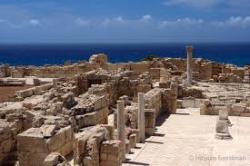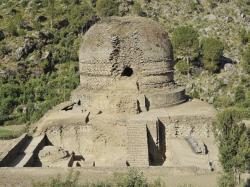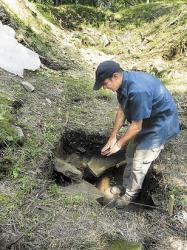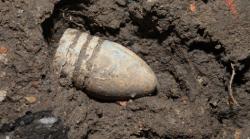INSTITUT SUPERIEUR D'ANTHROPOLOGIE
INSTITUTE OF ANTHROPOLOGY
ONLINE COURSES / COURS A DISTANCE
INSCRIPTION : Année Universitaire 2012/2013
REGISTRATION : Academic Year 2012 / 2013
CHYPRE –  Kourion - Digs at the ancient site of Kourion (Curium) have started revealing an early Byzantine cityscape with mosaic floors and signs of a cistern, the department of antiquities said yesterday following the completion of the first season of an excavation project. Archaeologists from the University of Cyprus and a Texas theological seminary hope to reveal how early Christians in Kourion lived. As part of the Kourion Urban Space Project (KUSP) archaeologists have found two mosaic floors and a floor fragment and have prepared them for conservation. The floor fragment is associated with a cistern. Future excavations will reveal the size and complexity of the mosaic floors, with one of them possibly including a figure and another decorated with geometric patterns. The foundations of a water structure – modified at least twice - have also been found. After the destruction of the city’s main aqueduct in an earthquake in 365AD, the Byzantines used the terrain to create flat surfaces for cisterns. Excavators also think they have found a luxurious villa with mosaic floors, built to benefit from the sea breeze. Kourion’s remains include a theatre, still used today to house events, a market place, public baths and mosaics. Some 10,000 people are believed to have lived there. One of the aims of the excavators is to find evidence of a ‘house-church’ where early Christians would meet to worship in secrecy.
Kourion - Digs at the ancient site of Kourion (Curium) have started revealing an early Byzantine cityscape with mosaic floors and signs of a cistern, the department of antiquities said yesterday following the completion of the first season of an excavation project. Archaeologists from the University of Cyprus and a Texas theological seminary hope to reveal how early Christians in Kourion lived. As part of the Kourion Urban Space Project (KUSP) archaeologists have found two mosaic floors and a floor fragment and have prepared them for conservation. The floor fragment is associated with a cistern. Future excavations will reveal the size and complexity of the mosaic floors, with one of them possibly including a figure and another decorated with geometric patterns. The foundations of a water structure – modified at least twice - have also been found. After the destruction of the city’s main aqueduct in an earthquake in 365AD, the Byzantines used the terrain to create flat surfaces for cisterns. Excavators also think they have found a luxurious villa with mosaic floors, built to benefit from the sea breeze. Kourion’s remains include a theatre, still used today to house events, a market place, public baths and mosaics. Some 10,000 people are believed to have lived there. One of the aims of the excavators is to find evidence of a ‘house-church’ where early Christians would meet to worship in secrecy.
http://www.cyprus-mail.com/kourion/ancient-luxury-villa-found-kourion/20120802
PAKISTAN –  Amluk-Dara - Local and foreign excavators revealed on Wednesday that a unique part of a previously-discovered site of the Gandhara civilization at Amluk-Dara, Swat, has been uncovered jointly by Italian Archaeological Mission in Pakistan and Khyber-Pakhtunkhwa’s (K-P) Directorate of Archaeology and Museums. Sheltered by the great Mount Elum, the Amluk-Dara stupa is an ancient relic two kilometres from the main road which travels from Barikot to Buner and stands with ancient majesty and can be seen from the surrounding mountains. Excavators working on the site that dates back to the third century recently discovered an entire complex surrounding the four-metre long stupa — which was first discovered by the Hungarian-British archaeologist Sir Aurel Stein in 1926. It was later studied by Domenico Faccena in the 60s and 70s. “Actually, Amluk-Dara is not a new discovery but a re-discovery. Sir Aurel Stein in 1926 reported the ruins and wrote that the main stupa was possibly one of the best preserved pieces of Buddhist architecture he had ever seen in Gandhara. The main stupa with its sacred area was founded around the third century and lasted until 10th or 11th century,” said Dr Luca Maria Olivieri, director of the Italian Archaeological Mission in Pakistan. Sculptures or fragments of the sculptural decoration of the stupas, interesting architecture – including a small pyramid-roofed shrine built just in the middle of the main stupa’s staircase – stucco decorations, potsherds and painted Shahi pottery dating back to the 7th-11th century were discovered during the excavation.
Amluk-Dara - Local and foreign excavators revealed on Wednesday that a unique part of a previously-discovered site of the Gandhara civilization at Amluk-Dara, Swat, has been uncovered jointly by Italian Archaeological Mission in Pakistan and Khyber-Pakhtunkhwa’s (K-P) Directorate of Archaeology and Museums. Sheltered by the great Mount Elum, the Amluk-Dara stupa is an ancient relic two kilometres from the main road which travels from Barikot to Buner and stands with ancient majesty and can be seen from the surrounding mountains. Excavators working on the site that dates back to the third century recently discovered an entire complex surrounding the four-metre long stupa — which was first discovered by the Hungarian-British archaeologist Sir Aurel Stein in 1926. It was later studied by Domenico Faccena in the 60s and 70s. “Actually, Amluk-Dara is not a new discovery but a re-discovery. Sir Aurel Stein in 1926 reported the ruins and wrote that the main stupa was possibly one of the best preserved pieces of Buddhist architecture he had ever seen in Gandhara. The main stupa with its sacred area was founded around the third century and lasted until 10th or 11th century,” said Dr Luca Maria Olivieri, director of the Italian Archaeological Mission in Pakistan. Sculptures or fragments of the sculptural decoration of the stupas, interesting architecture – including a small pyramid-roofed shrine built just in the middle of the main stupa’s staircase – stucco decorations, potsherds and painted Shahi pottery dating back to the 7th-11th century were discovered during the excavation.
http://tribune.com.pk/story/416236/amluk-dara-stupa-excavators-discover-unique-complex/
USA –  Volcano - Oyster shells, ceramic pieces, wine bottles and buttons were among the artifacts uncovered by a team of archaeology students from the site of Thornhill Mansion, the former estate of oil and gas pioneer W.C. Stiles. The unearthed artifacts will help paint a picture of the Stiles family and its way of life in the once-thriving oil town of Volcano in the late 1800s. "Each piece we find, no matter how small, offers clues to the past," said professional archaeologist Chris Nelson. "Whether it's a tiny piece of a ceramic plate, a button, or a broken wine bottle, they are all part of a bigger picture." This is the second excavation of the Stiles estate. Last year, the dig was confined to the foundation of the Stiles' residence, but this year it expanded to the gardener's residence several yards away. "We are expanding out from the mansion itself, trying to plot the landscape," he said Wednesday. "Historical documents and old photographs are a huge help in pinning down where exactly those other outbuildings were located, in relation to the mansion." Included on the estate were flower gardens, orchards, a tennis court, a barn, caretaker's house and a wine, vegetable and fruit cellar.
Volcano - Oyster shells, ceramic pieces, wine bottles and buttons were among the artifacts uncovered by a team of archaeology students from the site of Thornhill Mansion, the former estate of oil and gas pioneer W.C. Stiles. The unearthed artifacts will help paint a picture of the Stiles family and its way of life in the once-thriving oil town of Volcano in the late 1800s. "Each piece we find, no matter how small, offers clues to the past," said professional archaeologist Chris Nelson. "Whether it's a tiny piece of a ceramic plate, a button, or a broken wine bottle, they are all part of a bigger picture." This is the second excavation of the Stiles estate. Last year, the dig was confined to the foundation of the Stiles' residence, but this year it expanded to the gardener's residence several yards away. "We are expanding out from the mansion itself, trying to plot the landscape," he said Wednesday. "Historical documents and old photographs are a huge help in pinning down where exactly those other outbuildings were located, in relation to the mansion." Included on the estate were flower gardens, orchards, a tennis court, a barn, caretaker's house and a wine, vegetable and fruit cellar.
http://www.newsandsentinel.com/page/content.detail/id/563685/Dig-uncovers-artifacts-at-mansion-site.html?nav=5061
USA –  Williamsburg - Archaeologists working in the university's Brafferton Yard continue to uncover evidence of a time a century and a half ago in which the normally placid Historic Campus was a Civil War battleground. For much of the War Between the States, Williamsburg and the W&M campus were near the shifting line between the Union-controlled lower Peninsula and the Confederate upper portion. The William & Mary Center for Archaeological Research has excavated a small plot south of the Brafferton Kitchen that is crowded with features dating to the occupation of campus by Union troops 1862-65. Center director Joe Jones says his archaeologists have uncovered remains of ditches that marked palisades erected by Union troops in 1865 to defend their position against possible attacks by Confederates. There was apparently a fear Confederates might try to move east and down the Peninsula after Richmond and Petersburg fell into Union hands in 1865. The site also holds remains of a well dug, then apparently abandoned, by the occupying troops. Archaeologists also uncovered the remains of a foundation of a previously unrecorded outbuilding Jones believes predates the Civil War and may have been dismantled for building materials by the federal troops. The archaeologists have removed a number of supporting artifacts from the site, including an unfired Minié ball, a common Civil War rifle round. A number of clay marbles may be remnants of the leisure activities of the soldiers. Also found ewre a number of buttons, including a fine Confederate-issue button from a Virginia regiment. A gold-amalgam pen nib also was recovered, still shiny once the dirt was wiped off.
Williamsburg - Archaeologists working in the university's Brafferton Yard continue to uncover evidence of a time a century and a half ago in which the normally placid Historic Campus was a Civil War battleground. For much of the War Between the States, Williamsburg and the W&M campus were near the shifting line between the Union-controlled lower Peninsula and the Confederate upper portion. The William & Mary Center for Archaeological Research has excavated a small plot south of the Brafferton Kitchen that is crowded with features dating to the occupation of campus by Union troops 1862-65. Center director Joe Jones says his archaeologists have uncovered remains of ditches that marked palisades erected by Union troops in 1865 to defend their position against possible attacks by Confederates. There was apparently a fear Confederates might try to move east and down the Peninsula after Richmond and Petersburg fell into Union hands in 1865. The site also holds remains of a well dug, then apparently abandoned, by the occupying troops. Archaeologists also uncovered the remains of a foundation of a previously unrecorded outbuilding Jones believes predates the Civil War and may have been dismantled for building materials by the federal troops. The archaeologists have removed a number of supporting artifacts from the site, including an unfired Minié ball, a common Civil War rifle round. A number of clay marbles may be remnants of the leisure activities of the soldiers. Also found ewre a number of buttons, including a fine Confederate-issue button from a Virginia regiment. A gold-amalgam pen nib also was recovered, still shiny once the dirt was wiped off.
http://www.vagazette.com/news/va-vg-wm-find-0801-20120801,0,7210831.story